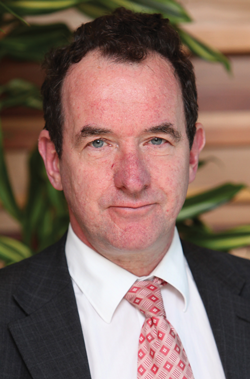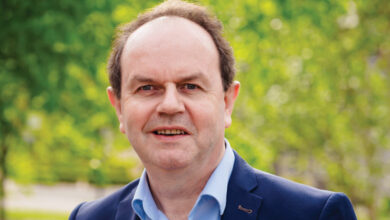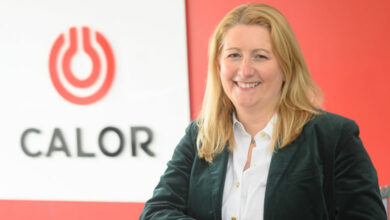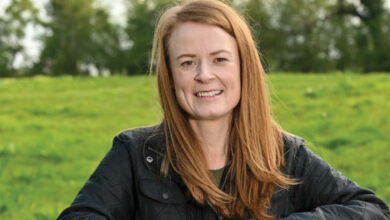Scotland’s 100 per cent target: Colin Imrie
 Colin Imrie, Head of the Scottish Government’s Energy and International Low Carbon Division, discusses Scotland’s
Colin Imrie, Head of the Scottish Government’s Energy and International Low Carbon Division, discusses Scotland’s
100 per cent renewable electricity target and rural revival with Stephen Dineen.
Scotland is aiming high. By 2020, the Scottish Government wants 100 per cent of gross electricity consumption demand and 30 per cent of all energy to be sourced from renewables. In practice, the 100 per cent target means the total amount of renewable electricity equalling total electricity demand. This means over 50 per cent of all electricity coming from renewable sources, and the continued use of non-renewable sources for reserve and exports.
In 2010, 24.1 per cent of electricity demand was met by renewables. The interim target for 2011 is 31 per cent, which is thought to have been met. Energy demand is to be reduced by 12 per cent by 2020. By the end of 2009, demand had fallen by 9.6 per cent from the 2005-2007 baseline.
It is a “major challenge,” Colin Imrie says of the 100 per cent target, which will require 15GW of renewable energy (current installed capacity is 4.6GW). It will be met “partly by all the onshore wind in the system,” and the deployment of marine renewables “and offshore wind particularly.”
Implementation of “a very clear vision” for grid upgrades and for developing energy storage systems are also required to meet the target. A further challenge lies in improving consenting and planning for renewable projects. “That’s why we’ve done some work over the last few months to make sure we’re ready to speed up the system for the offshore planning as well,” Imrie explains. This means “the right type of applications in the right place” and getting various agencies to work as effectively as possible “to get the planning applications through the system.”
Imrie doesn’t deny that there is public concern in certain areas regarding renewables projects. However, Scotland’s experience is that “the projects that get through the system best” are those that have “got the communities on side, and, increasingly, are actually involving the communities in implementation of the programme.”
The current Ofgem review of transmission charging, Project TransmiT, is an important factor in Scotland’s plans. The review has initially recommended a change from the existing investment cost-related pricing methodology to one improving the accuracy of cost targeting. “The Scottish Government has been campaigning on this for a few years,” Imrie says. This was “particularly to make sure” that exports from Scottish islands were “not made totally uneconomic by a methodology which disincentivises that investment.”
Project TrasmiT’s outcome is “absolutely crucial” in addressing the transmission costs from connection charges. “Some very major proposals,” for wind farms on the Western Isles and Shetland, and wave and tidal proposals around the Orkney islands, “fundamentally depend upon on getting these issues sorted.” Ofgem’s final recommendations are expected this spring.
Social and economic revival from the renewables ambition is already evident. “One of the encouraging things,” states Imrie, “particularly in our rural areas, is the way in which communities have been able to turn loss-making local estates in the remote areas of Scotland into areas where actually communities can control their own future.” Small hydro schemes and turbines, owned by the community, are creating income “that wasn’t there before,” bringing people back to areas “which are becoming more vibrant because they’ve got control over their energy future.”
Whiskey distilleries are already benefiting from going green. “They’re moving away from their dependence on fossil fuels to using waste and renewable energy,” he explains. He cites the Islay distilleries in the inner Hebrides. “Moving them to a renewable future, in partnership with the communities, will be a very important way of securing their long-term future.”
Whilst Scotland’s renewables targets are already ambitious, Imrie is excited by the ISLES project’s potential. “This can be an integral part of the EU’s infrastructure plan,” he says. Rather than the “far west of the Atlantic” being “on the edge of Europe,” the three jurisdictions involved could end up “at the centre of Europe.”





